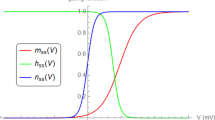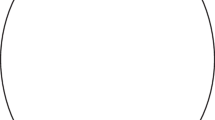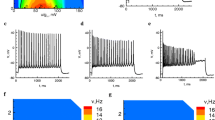Summary
The form of power spectra of K+ conduction fluctuations in patches of squid axon suggested that K+ conduction kinetics are higher than first order (Fishman, Moore & Poussart, 1975,J. Membrane Biol. 24:305). To obtain an alternative description of ion conduction kinetics consistent with spontaneous fluctuations, the complex impedance and admittance of squid (Loligo pealei) axon were measured at low frequencies (1–1000 Hz) with a four electrode system using white Gaussian noise as a stochastic perturbation. As predicted from the spontaneous noise measurements, a low frequency impedance feature is observed between 1 and 30 Hz which is voltage and temperature dependent, disappears after substantial reduction in [K + i ], and is unaffected by the state of Na+ conduction or active transport. These measurements confirm and constitute strong support for the patch noise measurements and interpretations. The linearized Hodgkin-Huxley (HH) equations do not produce the low frequency feature since first order ion conduction kinetics are assumed. Computation of diffusion polarization effects associated with the axon sheath gives a qualitative account of the low frequency feature, but the potential dependence is opposite to that of the data. Thus, K+ conduction kinetics in the axon are not adequately described by a single first order process. In addition, significant changes inHH parameter values were required to describe the usual impedance (resonance) feature inLoligo pealei axon data.
Similar content being viewed by others
References
Adelman, W.J., Jr., Palti, Y., Senft, J.P. 1973. Potassium ion accumulation in a periaxonal space and its effect on the measurement of membrane potassium ion conductance.J. Membrane Biol. 13:387
Barnes, J.A., Jarvis, S., Jr. 1971. Efficient numerical and analog modelling of flicker noise processes.Nat. Bur. Stand. Tech. Note 604
Bendat, J.S., Piersol, A.G. 1971. Random Data: Analysis and Measurement Procedures. Wiley-Interscience, New York
Brinley, F.J., Mullins, L.J. 1967. Sodium extrusion by internally dialyzed squid axons.J. Gen. Physiol. 50:2303
Canessa-Fischer, M., Zambrano, F., Rojas, E. 1968. The loss and recovery of the sodium pump in perfused giant axons.J. Gen. Physiol. 51:1625
Chandler, W.K., Fitzhugh, R., Cole, K.S. 1962. Theoretical stability properties of a spaceclamped axon.Biophys. J. 2:105
Cole, K.S. 1968. Membranes, Ions and Impulses. University of California Press, Berkeley
Conti, F., DeFelice, L.J., Wanke, E. 1975. Potassium and sodium ion current noise in the membrane of the squid giant axon.J. Physiol. (London) 248:45
Davies, W.D.T. 1970. System Identification for Self-Adaptive Control. Wiley-Interscience, London
Fishman, H.M. 1970. Direct and rapid description of the individual ionic currents of squid axon membrane by ramp potential control.Biophys. J. 10:799
Fishman, H.M. 1973. Low impedance capillary-electrode for wideband recording of membrane potential in large axons.IEEE Trans. Biomed. Eng. 20:380
Fishman, H.M. 1973a. Relaxation spectra of potassium channel noise from squid axon membranes.Proc. Nat. Acad. Sci. USA 70:876
Fishman, H.M. 1975. Rapid complex impedance measurements of squid axon membrane via input-output cross correlation function.In: Proceedings of First Symposium on Testing and Identification of Nonlinear Systems. G.D. McCann and P.Z. Marmarelis, editors. p. 257. California Institute of Technology, Pasadena
Fishman, H.M., Moore, L.E., Poussart, D.J.M. 1975. Potassium-ion conduction noise in squid axon membrane.J. Membrane Biol. 24:305
Fishman, H.M., Moore, L.E., Poussart, D.J.M., Siebenga, E. 1976. Non first-order K+ conduction impedance and noise feature in squid axon membrane.Biophys. J. 16:26a
Fishman, H.M., Poussart, D.J.M., Moore, L.E. 1975. Noise measurements in squid axon membrane.J. Membrane Biol. 24:281
Frankenhaeuser, B., Hodgkin, A.L. 1956. The after-effects of impulses in the giant nerve fibers ofLoligo.J. Physiol. (London) 131:341
Guttman, R., Feldman, L. 1975. White noise measurement of squid axon membrane impedance.Biochem. Biophys. Res. Commun. 67:427
Guttman, R., Feldman, L., Lecar, H. 1974. Squid axon membrane response to white noise stimulation.Biophys. J. 14:941
Kubo, R. 1957. Statistical-mechanical theory of irreversible processes. I. General theory and simple applications to magnetic and conduction problems.J. Phys. Soc. Jpn. 12:570
Lee, T.W. 1960. Statistical Theory of Communication. Whiley, New York
Marmarelis, P.Z., Naka, K.-I. 1974. Identification of multi-input biological systems.IEEE Trans. Biomed. Eng. 21:88
Matsumoto, N., Inoue, I., Kishimoto, U. 1970. The electric impedance of the squid axon membrane measured between internal and external electrodes.Jpn. J. Physiol. 20:516
Mauro, A., Conti, F., Dodge, F., Schor, R. 1970. Subthreshold behavior and phenomenological impedance of the squid giant axon.J. Gen. Physiol. 55:497
Neumcke, B. 1971. Diffusion polarization at lipid bilayer membranes.Biophysik 7:95
Nyguist, H. 1928. Thermal agitation of electric charge in conductors.Phys. Rev. 32:110
Siebenga, E., Meyer, W.A., Verveen, A.A. 1973. Membrane shot-noise in electrically depolarized nodes of Ranvier.Pfluegers Arch. 341:87
Takashima, S., Schwan, H.P. 1974. Passive electrical properties of squid axon membrane.J. Membrane. Biol. 17:51
Takashima, S., Schwan, H.P., Cole, K.S. 1975. Membrane impedance of squid axon during hyperpolarization and depolarization.Biophys. J. 15:39a
Takashima, S., Yantorno, R., Pal, N.C. 1975. Electrical properties of squid axon membrane. II. Effect of partial degradation by phospholipase A and pronase on electrical characteristics.Biochim. Biophys. Acta 401:15
Taylor, R.E. 1965. Impedance of squid axon membrane.J. Cell. Comp. Physiol. 66(suppl. 2):21
Author information
Authors and Affiliations
Rights and permissions
About this article
Cite this article
Fishman, H.M., Poussart, D.J.M., Moore, L.E. et al. K+ Conduction description from the low frequency impedance and admittance of squid axon. J. Membrain Biol. 32, 255–290 (1977). https://doi.org/10.1007/BF01905222
Received:
Revised:
Issue Date:
DOI: https://doi.org/10.1007/BF01905222




